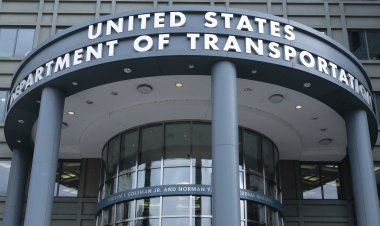Florida provided far more abortions than California and New York post-Dobbs. Here’s why.
It'll be years before many blue-state efforts to expand abortion access have an impact.


Last year’s Supreme Court decision overturning the constitutional right to abortion provoked a policymaking flurry in blue states that have long been bastions of reproductive rights.
From New York to California, Democratic lawmakers eagerly touted their states’ support for abortion care and unveiled initiatives to absorb an expected increase in out-of-state patients.
One year after the Dobbs decision, many of those efforts have not gotten off the ground. And while leading liberal states like New York and California saw some increases in the number of abortions, their numbers were far eclipsed by Florida because it borders states with severe abortion restrictions. The Republican-controlled state — where Gov. Ron DeSantis' six-week abortion ban remains tied up in court — saw the largest increase in abortions post-Dobbs.
Still, abortion providers in those coastal blue states expect significant investments made in reproductive health care in the wake of the ruling will have a greater impact in the coming years.
“It’s a marathon, not a sprint,” said Jessica Pinckney, CEO of ACCESS Reproductive Justice, a group in California that helps people with the extra costs of abortion, like travel and lodging. “It took decades to dismantle Roe, and building the highest quality access here in the state will take some time, but I do feel like we’re strongly on the right path,” she said in an interview.
Data compiled by the Society of Family Planning, a nonprofit organization that advocates for abortion access, ranked states with the largest increases in the total number of abortions provided by clinicians in the nine months after Dobbs, compared to the two months before the decision was announced. The nonprofit’s researchers caution that the state count is incomplete and, in some cases, includes their own estimates. It is also unclear how much of the increase was due to out-of-state patients.
Florida was first, with 12,460 more abortions in the months after the decision compared to the two months before. California was fifth, with 4,260 additional abortions and New York was 13th, with 2,320. After Dobbs, Florida had a 26 percent increase in abortions, California saw a 4 percent increase and New York a 0.6 percent increase compared to the two months before the decision was announced.
While Florida with its Republican governor and majority Republican statehouse did little to support abortion care, California and New York invested tens of millions of dollars into the effort. North Carolina saw a similar increase to Florida also because it’s so close to states with bans. While North Carolina’s Democratic governor has used his executive authority to increase safety measures for clinics, the majority Republican legislature is opposed to passing the kind of pro-abortion measures taken by bluer states.
In California, the state legislature poured $200 million into reproductive health care in the last year. The allocation included $20 million to expand services in Los Angeles and make it a hub for those coming in from out-of-state for abortions. Some of that money is going to build two new clinics expected to open next year, including one that provides abortions during all three trimesters.
There’s another $20 million set aside for travel and lodging for both in- and out-of-state patients. Essential Access Health, the group responsible for doling out grants, is taking care to distribute it slowly because the future is so uncertain, according to CEO Amy Moy.
“We’re looking at how to strike a balance of meeting the needs now and making sure that resources are being distributed,” Moy said. “We also want to make sure that we are able to be good stewards of the funds so that we have funding available until we’re able to rebuild the coffers.”
California also set aside $20 million for practices that treat uninsured patients or those whose insurance doesn’t cover abortions and another $20 million for a training corps program for clinicians, including nurse practitioners and resident doctors who can no longer get abortion experience in states with bans. It will be months or years before that program, the Reproductive Health Services Corps, turns out experienced physicians.
But speed is not the goal, said one abortion-rights advocate.
“I don’t think a year is enough for us to really understand the impact of Dobbs,” said Flor Hunt, executive director of the TEACH Program, which trains abortion providers. “I think for training, it’s taking even longer to really understand how that changes the landscape.”
Where the California funds have been disbursed, there’s been a clear impact on both local and out-of-state patients.
ACCESS Reproductive Justice, which has received $1.9 million from the state’s $200 million allocation, supported 481 callers looking for funds to help them get to their appointments, 80 percent of whom were Californians, in the year before Dobbs. After the ruling, the group supported 1,281 callers, 67 percent of whom were from California. The state funds allowed the group to double the size of its team and the number of calls they could return. Their budget in 2022 was $8,000 a month for the helpline. This fiscal year, it was $20,000 per month.
While last year California moved to improve access for patients, bills moving through the Legislature this year focus on clinicians. The proposals include efforts to shield them from civil or legal liability from states that have criminalized the procedure, increase privacy restrictions for medical records and limit the ability of bounty hunters to come after doctors in California who have treated patients from more restrictive states.
Across the country in New York, the Dobbs decision drove state lawmakers to approve a long-stalled proposal to enshrine abortion rights in the state constitution last summer. Gov. Kathy Hochul called it “the boldest step” the state could take to ensure abortion access. But the constitutional amendment still needs to be passed by voters, who won’t see it on their ballots until next year.
More recent measures to increase access, including over $22 million for Medicaid rate increases for surgical abortions and family planning services, were approved earlier this year but have yet to take effect.
Leaders with two New York abortion providers said they are seeing more patients from an increasing number of states come through the door post-Dobbs, but not so many that they have to dramatically increase capacity. Still, the decision underscored the importance of planning for what-ifs.
“We don’t know what else is going to happen,” Wendy Stark, president and CEO of Planned Parenthood of Greater New York, said in an interview. “In the long game, I believe it's our responsibility to continue to build capacity for whatever happens next.”
That kind of capacity-building was the idea behind a $25 million fund launched by Hochul last year to help local abortion and family planning providers reach more patients.
One recipient, Public Health Solutions, used a $351,000 award to train nurse practitioners on caring for medication abortion patients and to purchase a new ultrasound. April Lockley, the nonprofit’s medical director of sexual and reproductive health centers, said that seeing out-of-state patients has become an everyday occurrence post-Dobbs but that its clinics have so far been able to handle the increase.
Hochul also pledged $10 million to help providers implement security measures, but just $1.7 million was distributed. Asked what the state plans to do with the unused money, a spokesperson for the governor said the administration is evaluating next steps.
Like California, New York state lawmakers have also focused on shielding abortion providers from legal or professional misconduct charges and protecting the privacy of out-of-state patients after the Dobbs ruling cleared the way for over 20 states to criminalize the procedure though there’s little evidence of targeting doctors outside those jurisdictions.
But Chelsea Williams-Diggs, interim executive director of the New York Abortion Access Fund, which helps patients pay for the procedure, said the state has largely ignored one of the tallest barriers to access: the cost.
While New York’s Medicaid program covers abortion, Williams-Diggs said in an interview some providers do not accept Medicaid, and others only do so for patients early in their pregnancies. The average cost of a first-trimester abortion in New York is $600, Williams-Diggs said. In recent weeks, her organization has seen people later in their pregnancies be charged as much as $25,000 by private clinics.
Since the Dobbs ruling, Williams-Diggs said that her organization, which relies primarily on private donations, has pledged $1.7 million to support more than 2,000 people seeking an abortion in New York. In 2021, that sum was just over $500,000.
Last year, state lawmakers proposed an initiative that would support abortion providers as well as nonprofits that help people obtain an abortion but don’t offer the procedure themselves — similar to what California later did. The Hochul administration was skeptical, citing concerns that there would be inadequate funding for both causes, according to a person familiar with the negotiations who was granted anonymity to discuss internal deliberations.
One week later, Hochul launched her provider support fund, but nonprofits like Williams-Diggs’ that don’t actually offer abortions were ineligible.
“We are not living up to our brand, or our name, as a safe haven,” she said, citing the prohibitive cost of the procedure for many patients.
But both New York and California are setting examples for other Democratic-led states to follow in the absence of federal protections.
Jennifer Driver, a reproductive rights director for a California-based progressive policy group called State Innovation Exchange, holds Friday meetings with state lawmakers, alternating weeks between those from restrictive abortion states and those from access states.
California’s strategy of shielding both patients and providers from out-of-state legal action is one of the most effective things the state can do, she said. It’s being replicated in Illinois, Massachusetts and Minnesota.
Maryland is also following California and New York’s lead on shield laws for medical records, putting the right to abortion in the constitution and training providers from other states.
“We learned from what the other blue states had done and made sure to do it also,” said Maryland State Sen. Ariana Kelly, a Democrat from Montgomery County.
The difficulties around implementing new policies aside, the politics of abortion have always been a winning issue for Democrats both in states and the national stage. It is only becoming more relevant as red states continue to restrict rights, said Robin Swanson, a Democratic strategist in Sacramento.
That’s going to continue on the national stage, where California Gov. Gavin Newsom and his Florida counterpart, DeSantis, are “champing at the bit to highlight their differences,” Swanson said.
Because most of the country supports abortion access, Swanson said, it’s especially a winning issue for Newsom.
“I do think there’s a chance to capture centrist Republicans and Republican-leaning women, as long as we lead with this issue and talk about it as a fundamental civil right,” Swanson said.












